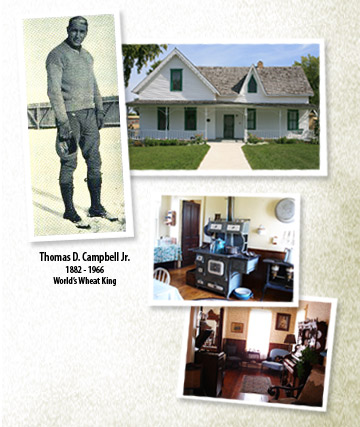The Campbell House was built by Thomas Campbell Sr. and Almira (Richards) Campbell, who immigrated to Grand Forks from Perth, Ontario, in 1875. That year, they purchased eighty acres of land and built a sod claim shanty near the present Campbell House. In 1879, they built a large log cabin, and then an addition on its southern side sometime in the 1890s. The Campbell House remained on its original site until 2004 when it had to be moved slightly forward to accommodate the flood-wall.
The Campbells were of Scottish descent. They had five children: four daughters and one son. Two of their daughters, Katie and Florence, died in childhood, and daughter Geneva died in 1918. They are all buried in Memorial Park Cemetery in Grand Forks. Their daughter Elizabeth married and moved to Winnipeg, Manitoba, to raise her family there. Thomas Sr. and Almira moved back to Perth, Ontario, around 1908 to be near family members.
Thomas Jr. was born on February 19, 1882. He attended local schools and graduated valedictorian of Central High School in 1898. He then attended Upper Canada College, a preparatory school in Toronto, Ontario. Returning to Grand Forks, he attended the University of North Dakota and received the first engineering degree from UND in 1904.
Campbell married Bess McBride Bull in 1906, daughter of a founder of Cream of Wheat, George Bull. Thomas Jr. and Bess left Grand Forks around 1910 (reportedly for Bess’s health) and relocated in Pasadena, California. The Campbell House was used as a rental property for many years after that, and then was left vacant.
Tom Jr. went to work for the J.S. Torrance Farming Corporation in California, where he made contacts that helped make his dream of owning a gigantic wheat farm possible. Eventually, he started his own farming company called the Campbell Farming Corporation.
Campbell signed leases with members of the Crow tribe near Hardin, Montana, whose land allotments he wanted to use, and paid rent money to these individuals annually. The farm’s first full year of production was in 1919. Thanks to Campbell, the Crow people earned income from their lands that they could not afford to farm themselves, and many of their young men obtained jobs on the Campbell farm, increasing their families’ income further. Campbell’s permanent residence was in Pasadena, but he traveled to Hardin seasonally during spring planting and fall harvest to work alongside his employees. The gigantic wheat farm eventually encompassed 95,000 acres.
Campbell was a popular man in the Hardin area. A progressive thinker, he utilized the most modern methods of his day to produce wheat at a low cost. He also paid fair wages and encouraged competition among his work crews to gain more efficient production, with the best crews receiving cash bonuses for their efforts.



